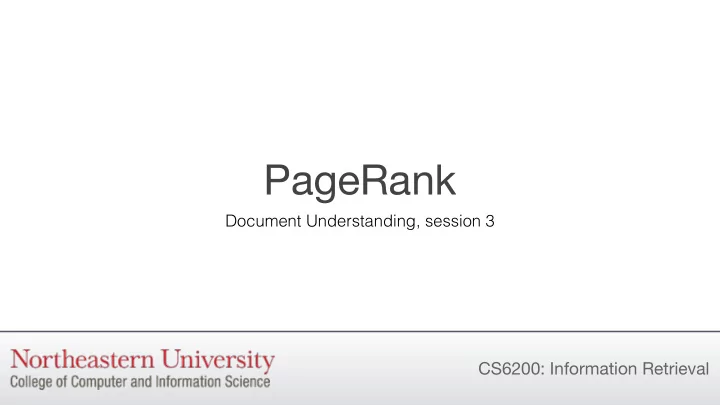

PageRank Document Understanding, session 3 CS6200: Information Retrieval
Link Structure of the Web The Internet is a graph of web pages Authoritative Page that link to each other. In most cases, these links can be seen as endorsements by a page author of the content on some other page. Endorsed Pages – Also Good? Building on this assumption, we can create a ranking score for web pages based purely on how many endorsements they receive from high- How about this one? quality pages. This is PageRank.
The Random Surfer Consider the following random experiment: A Start at a web page chosen uniformly at random. At each time t , flip a biased coin (e.g. probability of heads is λ ). If the coin comes up heads, follow a link chosen at random from the current page. Otherwise, choose a new page uniformly B C at random. PR ( C ) ≈ 1 2 PR ( A ) + 1 The PageRank of a particular page is the 1 PR ( B ) expected fraction of visits the surfer would make to it.
Teleportation in PageRank A The surfer’s ability to choose a random page instead of following a link is called teleportation . The surfer needs to teleport in order to B C escape from dead-end link cycles, and from pages with no out-links. A trap for naive surfers
Calculating PageRank More precisely, the PageRank of a page is: PR ( v ) PR ( u ) = λ � N + ( 1 − λ ) | outlinks ( v ) | v ∈ inlinks ( u ) One way to calculate it is to initialize all PageRanks to 1/ N , then iteratively update each page in turn until the process converges. A standard convergence test is when � new � old � < τ for some τ ≤ 1 . Smaller N values of τ are more accurate but take longer to converge.
PageRank with Linear Algebra if | outlinks ( i ) | = 0 1 PageRank can also be calculated N else if j ∈ outlinks ( i ) λ 1 − λ N + P i , j = using the transition probability matrix P | outlinks ( i ) | else λ of the random experiment. N P i , j ∈ ( 0 , 1 ) is prob. of transition from i to j N � A λ = 0 . 3 P i , j = 1 ∀ i , j = 1 2 / 20 9 / 20 9 / 20 1 / 10 1 / 10 8 / 10 The largest eigenvalue of P is 1 . The 8 / 10 1 / 10 1 / 10 corresponding left eigenvector gives B C the PageRank of each page.
Problems with PageRank The original implementation of PageRank has several known flaws. Importantly, it can be easily A D manipulated. • Link farms – large collections of inexpensive sites can be created to artificially boost a page’s rank by linking to it. B C E • Link spam – blog comments can link to an unrelated page, causing the A link farm: D and E unfairly blog to artificially “endorse” the page. boost C’s PageRank.
Wrapping Up PageRank is a query-independent signal of a page’s quality, based on endorsements by other pages online. It has some issues in its original form, but successive generations have removed some of these issues. Next, we’ll see an updated form of PageRank which attempts to calculate page quality for a particular user.
Recommend
More recommend